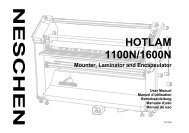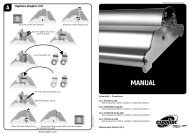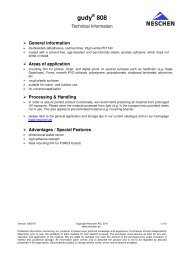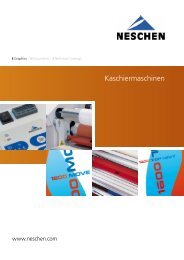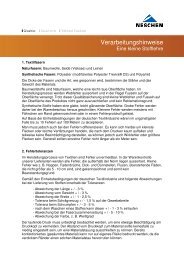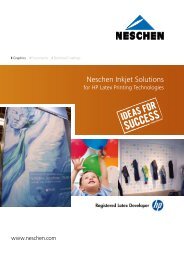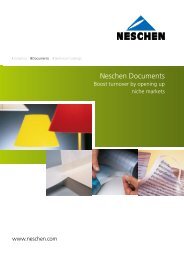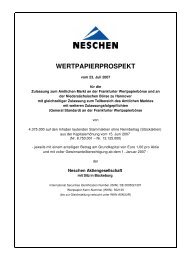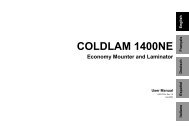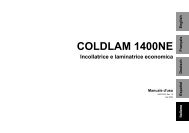Annual Report 2005
Annual Report 2005
Annual Report 2005
You also want an ePaper? Increase the reach of your titles
YUMPU automatically turns print PDFs into web optimized ePapers that Google loves.
56<br />
Notes relating to the consolidated annual accounts<br />
Trade receivables and other assets<br />
Trade receivables are classified as “advances and debts managed by the company” in accordance with IAS 39 “Financial instruments: recognition and measurement”<br />
and shown at acquisition cost. If doubts should arise regarding recovery, customer debts will be shown at their lower realisable value. Besides the necessary<br />
individual value adjustments, recognisable risks from the general credit risk will be taken into account by carrying out general value adjustments.<br />
All other receivables and assets are shown at acquisition cost.<br />
Evidence of depreciation will be taken into account by applying appropriate unscheduled depreciation to the lower recoverable amount.<br />
In principle, non-interest-bearing receivables with a residual term of more than one year will be discounted and shown at their current value.<br />
Securities<br />
Securities are classified as “held for trading purposes” or as “available for sale” in accordance with IAS 39 “Financial instruments: recognition and measurement”<br />
and valued at fair value.<br />
Liquid assets<br />
Cash and cash equivalents include cash assets, cheques and bank funds which are immediately available with an original term of up to three months and shown<br />
at nominal value.<br />
Income taxes<br />
Income taxes represent the total actual income taxes and deferred income taxes.<br />
Deferred taxes are calculated in accordance with IAS 12 “Income taxes”. Tax relief and tax charges which are likely to arise in the future will be shown for temporary<br />
differences between the book values shown in the Group financial statement and the tax valuations for assets and liabilities. Tax savings expected from<br />
the utilisation of loss carry-forwards which are considered to be realisable in the future will be shown as assets.<br />
Deferred tax assets for deductible temporary differences and tax loss carry-forwards which exceed the deferred tax liabilities from taxable temporary differences<br />
will only be recognised to the extent that it is sufficiently probable that sufficient taxable income will be obtained in order to realise the corresponding benefit.<br />
Deferred taxes will be valued at the rates expected to be valid for the period in which an asset is realised or a liability is discharged. Deferred taxes will be shown<br />
as tax proceeds or tax expenditure in the profit and loss account unless they relate to items entered directly under shareholders’ equity capital without affecting<br />
income. If that is the case, the deferred taxes will also be entered under shareholders’ equity capital without affecting income.<br />
Transitory items<br />
Transitory depreciation is shown in connection with deferred charges to expenses and deferred credits to income.<br />
Provisions<br />
The actuarial valuation of pension provisions for company pension schemes is carried out in accordance with the projected unit credit method prescribed in IAS<br />
19 “Employee benefits”. This procedure based on the present value of entitlement takes account of both the known pension and entitlements accrued on the closing<br />
date as well as increases in wages and pensions to be expected in the future. Differences arising at the end of the year (so-called actuarial profits or losses)<br />
between scheduled pension obligations determined and the actual value of entitlement will only be shown if they lie outside a margin of 10% of the scope of the<br />
obligation. If that is the case, they will be distributed over the average remaining period of service of employees with an entitlement from the following year and<br />
entered as income or expenditure. The pro rata interest relating to the addition to reserve included under pension costs will be shown as an interest expense within<br />
the financial result.<br />
Other provisions for pensions and similar obligations will be created based on actuarial reports in accordance with IAS 19.<br />
Other provisions will be created in the case of legal or de facto obligations to third parties which are based on past business transactions or events and which<br />
will probably (more than 50% likely to occur) lead to asset outflows which can be reliably determined.<br />
They will be shown at their expected realisable value taking account of all the resulting recognisable risks and not offset against rights of recovery. The realisable<br />
value with the highest probability of occurrence will be used in each case.<br />
Provisions for warranty costs will be entered when the product in question is sold. The amount entered as the provision represents the best possible estimate of<br />
the expenditure required to meet the current obligation.<br />
Provisions for restructuring will be entered once the Group has drawn up a formal plan for the restructuring program and it has been distributed to the units to<br />
be affected by the program.




